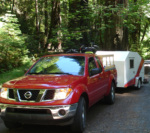 Thanks Doug
Thanks DougTorsion box
16 posts
• Page 1 of 2 • 1, 2
Torsion box
When I build, the floor will be 9X5 and I will be using a torsion box. Do I run the uninteruped wood (not the plywood) the long way and the interuped wood the short way or the other way around. I expect the floor to be 1/4 inch top and bottom and the stringers will be 3/4 material. I'm confused now are you. Anyway I hope you know what I mean,  Thanks Doug
Thanks Doug
 Thanks Doug
Thanks Doug-

sdakotadoug - Teardrop Advisor
- Posts: 71
- Joined: Sat Jul 10, 2010 6:50 pm
- Location: Southeast South Dakota
In cabinet and door making, the long pieces are the uninterrupted ones.
The long pieces are called stiles, and the shorter cross pieces are called rails. I don't know if this applies to torsion box construction, but it is universal in door and cabinet face construction.

The long pieces are called stiles, and the shorter cross pieces are called rails. I don't know if this applies to torsion box construction, but it is universal in door and cabinet face construction.

-

Cliffmeister2000 - Titanium Donating Member
- Posts: 3622
- Images: 157
- Joined: Thu Jul 26, 2007 10:18 pm
- Location: Phoenix, AZ




